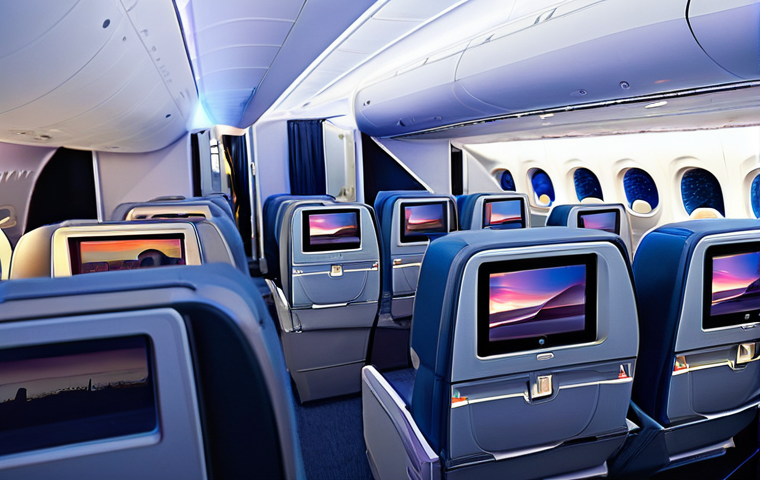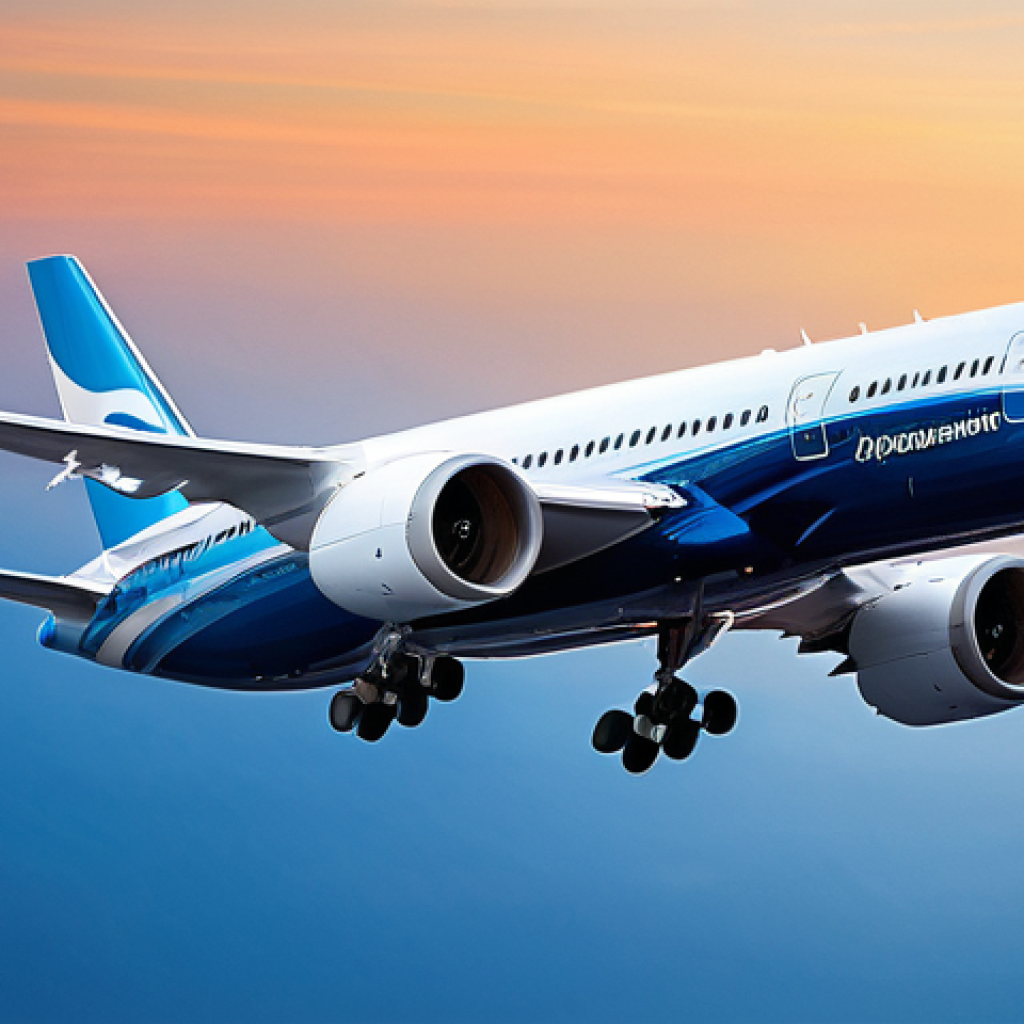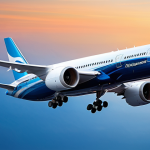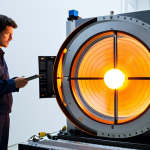The rivalry between Boeing and Airbus has always fascinated me, and as someone who’s traveled extensively, I’ve seen firsthand how their innovative engineering shapes our skies.
These two aviation titans aren’t just building planes; they’re pushing the boundaries of what’s possible, from developing hyper-efficient engines and advanced composite materials to pioneering sustainable aviation fuels (SAF) and even exploring hydrogen-powered aircraft.
It’s a constant race to deliver better performance, superior passenger comfort – like Boeing’s 787 Dreamliner with its lower cabin altitude and quieter engines, or Airbus’s A350 known for its quietest twin-aisle cabin – and a more environmentally friendly future for air travel.
With both companies heavily invested in next-generation narrowbody aircraft and addressing challenges like supply chain stability, it’s a dynamic landscape that impacts everything from ticket prices to our planet.
I’ve always been curious about the nuanced differences, and I bet you are too. Let’s unpack the intricate technological battle between Boeing and Airbus and what it means for the future of flight!
Crafting the Skies: The Quest for Aerodynamic Supremacy

It’s always been fascinating to watch how both Boeing and Airbus push the boundaries of what a commercial aircraft can be. When I first stepped onto a Boeing 787 Dreamliner, I immediately noticed how sleek it looked, almost futuristic, and that feeling translated into the flight itself – remarkably smooth.
A big part of that experience comes down to their mastery of aerodynamics and the innovative materials they’re using. We’re talking about more than just metal; both companies have heavily invested in advanced composite materials for fuselage and wing construction.
This isn’t just about making planes lighter, though that’s a huge benefit for fuel efficiency. It’s about designing shapes that cut through the air with incredible efficiency, reducing drag and making flights quieter and more comfortable for us, the passengers.
I remember being on a flight where turbulence seemed to barely register, and I couldn’t help but think about the countless hours of design and engineering that went into making that possible.
The subtle curves of a wing, the shape of the fuselage – every single detail is meticulously optimized. This focus on aerodynamic finesse is a core part of their enduring rivalry, driving them to constantly innovate.
The Magic of Composites: Lighter, Stronger, Further
When companies started talking about using composite materials like carbon fiber reinforced polymers for major parts of an aircraft, I admit I was a bit skeptical.
How could plastic be stronger than metal? But seeing the results, particularly with the Boeing 787 and Airbus A350, has been truly eye-opening. These materials aren’t just lighter; they’re incredibly durable and resistant to fatigue and corrosion, which means less maintenance over time and a longer operational life for the aircraft.
From a passenger perspective, the enhanced strength allows for larger windows and a lower cabin altitude, making the air feel less dry and pressurizing.
I’ve personally found flights on these newer composite-heavy aircraft to be significantly more comfortable, arriving feeling less drained. It’s a game-changer that fundamentally reshapes the economics and experience of air travel, and both giants are clearly all-in on this technological leap.
Wing Wisdom: Aerodynamic Finesse in Action
Have you ever looked closely at the wing of a modern airliner? It’s not just a flat surface; it’s a marvel of engineering, sculpted to perfection. Boeing and Airbus both employ incredibly sophisticated wing designs, often featuring advanced raked wingtips or winglets that significantly reduce induced drag.
I recall flying over the Atlantic and looking out at the wing, noticing how effortlessly it seemed to glide through the air, even at high speeds. These designs aren’t just for show; they directly contribute to fuel efficiency, allowing airlines to fly further with less fuel, which translates into cost savings for them and, ideally, better prices for us.
Beyond the obvious wingtips, the entire profile of the wing, from its curvature to its thickness, is optimized for specific flight regimes. It’s a testament to their engineering prowess that they can extract such efficiency from seemingly subtle design variations, always striving for that extra edge in performance.
Powering the Future: Engines, Efficiency, and Emissions
The heart of any modern aircraft is undoubtedly its engines, and the advancements in this area over the past few decades have been nothing short of astounding.
When I started flying frequently, the roar of a jet engine on takeoff was just part of the experience, but now, I often find myself marveling at how much quieter and smoother the departure feels, even from inside the cabin.
Both Boeing and Airbus are deeply intertwined with engine manufacturers like GE Aviation, Rolls-Royce, and Pratt & Whitney, constantly pushing for more powerful, yet incredibly fuel-efficient and quieter powerplants.
This isn’t just about reducing noise complaints around airports; it’s a critical component of their sustainability goals and, let’s be honest, a massive factor in airline operating costs.
A more fuel-efficient engine directly translates to lower operational expenses, making an aircraft more attractive to buyers. It’s a relentless pursuit of engineering perfection, balancing immense thrust with minimal environmental impact, and frankly, I’m always impressed by how they manage to squeeze out even more performance each year.
The Engine Room: Pushing the Limits of Propulsion
It’s easy to take for granted the incredible power and precision of jet engines, but these aren’t just simple combustion machines; they are highly sophisticated pieces of technology.
Modern turbofans are designed with bypass ratios that direct a large proportion of air around the core engine, significantly increasing efficiency and reducing jet noise.
I’ve often thought about the sheer complexity involved when I see these massive engines being serviced on the tarmac, knowing that every component, from the fan blades to the combustion chamber, is engineered to withstand extreme temperatures and pressures.
Both Boeing’s and Airbus’s aircraft benefit from these continuous innovations. For instance, the GEnx engines on the Boeing 787 or the Rolls-Royce Trent XWB on the Airbus A350 represent peak performance, delivering incredible thrust while consuming significantly less fuel than their predecessors.
This constant evolution in propulsion technology is truly what keeps our skies moving forward, allowing for longer, more economical flights.
Silent Skies: Tackling Noise Pollution and Fuel Burn
One of the most noticeable improvements for anyone living near an airport, or even inside the cabin, is the dramatic reduction in aircraft noise. This isn’t an accident; it’s a direct result of design innovations in engine technology.
I remember when taking off, the sheer volume was almost oppressive, but now, on many modern aircraft, it’s a much more muted rumble. Beyond noise, the drive for reduced fuel burn is paramount, not just for the environment but for airline bottom lines.
Every percentage point saved in fuel consumption translates to millions of dollars annually for major carriers. Engine manufacturers, in close collaboration with Boeing and Airbus, are exploring everything from advanced materials that can withstand higher operating temperatures (improving thermodynamic efficiency) to sophisticated aerodynamic designs within the engine itself to minimize energy loss.
It’s truly a testament to their commitment to both economic viability and environmental responsibility, making each flight a little bit ‘greener’ and a lot quieter.
Beyond the Seat: Engineering the Passenger Experience
As a frequent traveler, I’ve spent countless hours in airplane cabins, and I can tell you, the difference between a good cabin experience and a great one is palpable.
This isn’t just about the seat you choose; it’s about the entire environment designed by Boeing and Airbus. I’ve personally found that the atmosphere on a Boeing 787, with its lower cabin altitude and increased humidity, makes a noticeable difference on long-haul flights – I feel less tired and dehydrated upon arrival.
Conversely, Airbus has often been lauded for its slightly wider cabin cross-sections, particularly on models like the A350, which can translate to a bit more personal space, even in economy.
It’s a subtle but significant battle fought in millimeters and cubic feet, all aimed at making those hours in the sky as comfortable as possible. They’re constantly innovating, from mood lighting that helps with jet lag to advanced air filtration systems that keep the air fresh.
It genuinely feels like they’re listening to feedback and striving to improve our journey, understanding that comfort is a huge part of customer loyalty for airlines.
Cabin Comfort Wars: Breathing Easier, Feeling Better
The competition for passenger comfort is fierce, and it’s where both manufacturers really try to differentiate themselves. Boeing, with its Dreamliner, made a big splash by engineering a cabin that feels more like being at 6,000 feet than 8,000, and my body definitely appreciates that on a twelve-hour flight.
Plus, the higher humidity means you’re not gasping for water quite as much. Airbus, not to be outdone, often boasts about its “Airspace by Airbus” cabins, focusing on wider seats, more overhead bin space, and quieter environments.
I remember being on an A350 and truly being impressed by how quiet the cabin felt, even near the engines. It’s these kinds of details that can make or break a long journey, and it’s clear both companies are pouring resources into making the passenger environment as appealing as possible, realizing that a happy passenger is a loyal passenger for their airline customers.
Connectivity and Convenience: The Digital Flight Experience
In today’s connected world, a flight isn’t just about getting from A to B; it’s about staying connected and entertained. Both Boeing and Airbus are working closely with airlines to integrate cutting-edge inflight entertainment (IFE) systems and Wi-Fi solutions.
I’ve seen firsthand the evolution from clunky seat-back screens to sleek, responsive touchscreens with a vast array of movies, TV shows, and even live news.
And reliable Wi-Fi? It’s almost a non-negotiable for me now on any long flight. While the actual service is often provided by third-party vendors, the aircraft manufacturers design the infrastructure to support these systems, ensuring seamless integration.
It’s a race to provide faster, more consistent internet access and a broader, more personalized entertainment offering. For someone who often works on the go, having that seamless digital experience is invaluable, and it shows that these aviation giants are not just thinking about the mechanics of flight, but the entire end-to-end user experience.
Tomorrow’s Flightpath: Navigating Sustainable Aviation
When I think about the future of flying, my mind immediately goes to sustainability. It’s a topic that’s increasingly on everyone’s radar, and frankly, it gives me hope to see how seriously both Boeing and Airbus are taking it.
They’re not just making small tweaks; they’re investing heavily in groundbreaking technologies that could fundamentally transform air travel. From the development and certification of sustainable aviation fuels (SAF) to ambitious research into hydrogen-powered aircraft, it’s a full-court press to decarbonize the industry.
I’ve heard many discussions about the challenges – the sheer scale needed for SAF production, the infrastructure required for hydrogen – but the commitment is undeniable.
It’s inspiring to think that the same companies that brought us the jet age are now working to ensure that future generations can enjoy the freedom of flight without the same environmental footprint.
This isn’t just PR; it’s a massive shift in engineering priorities, driven by both regulatory pressures and a genuine desire to protect our planet.
Green Wings: The Promise of Sustainable Aviation Fuels
Sustainable Aviation Fuels (SAF) are often touted as one of the most immediate and impactful ways to reduce aviation’s carbon footprint, and both Boeing and Airbus are huge proponents.
I’ve followed the news closely, seeing various airlines conducting test flights powered partly or entirely by SAF, and it’s genuinely exciting. These fuels, derived from sources like waste oils, agricultural residues, or even algae, can significantly reduce lifecycle greenhouse gas emissions compared to traditional jet fuel, often by 80% or more.
The challenge, of course, is scaling up production to meet global demand, but both manufacturers are actively collaborating with energy companies and governments to accelerate this.
For me, knowing that the plane I’m on could be running on a more environmentally friendly fuel makes a big difference in how I feel about air travel. It’s a tangible step towards a greener future, and I’m eager to see how quickly it becomes the industry standard.
Hydrogen Horizons: A Glimpse into Zero-Emission Flight
While SAF offers a near-term solution, the concept of hydrogen-powered aircraft is truly revolutionary, promising potentially zero in-flight carbon emissions.
Airbus, in particular, has been very vocal about its “ZEROe” concepts, exploring various designs for hydrogen-combustion or hydrogen fuel-cell powered planes, aiming for commercial service by 2035.
Boeing is also researching hydrogen, albeit perhaps with a more cautious public approach, but their engineers are undoubtedly working on similar frontiers.
I’ve thought about what it would be like to fly on a plane with no exhaust fumes, only water vapor, and it feels like science fiction becoming reality.
The engineering challenges are immense – hydrogen storage (liquid hydrogen requires cryogenic temperatures and takes up more space than jet fuel), distribution infrastructure, and engine design – but the potential rewards are enormous.
It represents the ultimate long-term vision for sustainable aviation, and watching these two titans race towards it is truly captivating.
The Production Puzzle: Supply Chains and Global Reach
Even the most brilliant aircraft designs and efficient engines mean little if you can’t actually build and deliver the planes. This is where the intricacies of global supply chains come into play, a challenge both Boeing and Airbus know intimately.
Over the past few years, especially, we’ve seen how disruptions can ripple through the entire industry, delaying deliveries and impacting airline expansion plans.
I’ve heard directly from airline executives about the frustration of waiting for crucial components, and it makes you realize just how complex the manufacturing process is.
We’re talking about millions of parts, sourced from thousands of suppliers across dozens of countries, all needing to arrive at the right place at the right time.
It’s a logistical ballet of immense scale, and both companies are constantly optimizing these networks, trying to build resilience and reduce vulnerabilities.
It’s a crucial aspect of their rivalry that often goes unnoticed by the public but directly affects everything from ticket prices to the availability of new routes.
Assembly Line Acrobatics: Orchestrating a Global Network
Imagine coordinating the delivery of millions of parts, from massive fuselage sections built in distant factories to tiny, highly specialized electronics, all to multiple assembly lines across continents.
That’s the daily reality for Boeing and Airbus. I’ve seen documentaries showcasing these massive assembly plants, and it’s mind-boggling to think about the synchronization required.
Each major component, whether it’s a wing from the UK or an engine from the US, represents a significant logistical challenge. The companies spend vast sums on managing these complex webs, using advanced digital tools to track every nut, bolt, and panel.
The goal is to ensure a smooth, continuous flow of parts, minimizing bottlenecks and maximizing output. It’s a testament to human ingenuity, really, seeing how they piece together these incredibly complex machines from such a geographically diverse set of suppliers.
Turbulence on the Tarmac: Dealing with Production Delays
Recent years have highlighted just how fragile even the most robust supply chains can be. I’ve personally experienced flights being delayed or even canceled due to an airline not receiving its new aircraft on schedule, which then impacts their entire fleet plan.
Both Boeing and Airbus have faced significant challenges, from shortages of raw materials to labor issues at supplier factories. These delays aren’t just inconvenient; they cost airlines immense sums in lost revenue and leasing costs.
Consequently, both manufacturers are constantly looking for ways to de-risk their supply chains, perhaps by diversifying suppliers, investing in automation, or even bringing some production in-house.
It’s a high-stakes game where even a small disruption in one corner of the world can have a cascading effect, delaying the delivery of a multi-million-dollar aircraft and impacting travel plans for millions of passengers globally.
Strategic Maneuvers: Market Share and the Business of Flight
The competition between Boeing and Airbus isn’t just about building better planes; it’s a high-stakes chess match played out in boardrooms and at airshows around the world.
Every order won or lost shifts the balance of power, influencing future designs, production rates, and even global trade relations. I’ve always found it fascinating to see how they strategically position their aircraft families against each other, particularly in the lucrative narrowbody market with the Boeing 737 MAX and Airbus A320neo families.
These smaller, single-aisle jets are the true workhorses of the industry, flying the vast majority of passengers on shorter routes, and securing orders for them is absolutely critical.
But the battle extends to widebodies too, where the 787 and A350 go head-to-head. It’s a relentless pursuit of market dominance, with each company trying to anticipate airline needs, offer the most compelling financial packages, and build relationships that can last for decades.
This rivalry shapes the entire commercial aviation landscape, affecting everything from airline business models to the choices we have as travelers.
The Order Books: A High-Stakes Game
Watching the major airshows, like Farnborough or Paris, feels a bit like watching a corporate sporting event. The daily announcements of new orders are closely scrutinized, with each company vying to come out on top.
I’ve often seen how a big order from a major airline can send ripples through the industry, signaling confidence in one manufacturer over the other. It’s not just about the number of planes, though; the value of these orders can run into tens of billions of dollars.
Airlines are looking at a multitude of factors: fuel efficiency, maintenance costs, passenger comfort, delivery slots, and of course, the price. Both Boeing and Airbus employ dedicated sales teams that spend years cultivating relationships, understanding the specific needs of each carrier, and then tailoring bespoke packages.
It’s a long game, and the decisions made today will impact their market position for years, even decades, to come.
Geopolitical Winds: Navigating Global Markets
It’s impossible to talk about the Boeing-Airbus rivalry without acknowledging the significant geopolitical factors at play. Both companies are deeply tied to the economic and political interests of their home regions – the US for Boeing and Europe for Airbus.
This means that trade policies, government subsidies, and international relations can all influence purchasing decisions and market access. I’ve often thought about how complex this must be for them, having to navigate not just commercial competition but also diplomatic considerations.
For example, a country might favor one manufacturer over another based on broader trade agreements or strategic alliances. This adds an extra layer of complexity to their sales strategies, making the competition even more intense.
It’s a reminder that the aviation industry isn’t just about engineering; it’s also deeply embedded in the intricate web of global politics and economics.
| Feature/Aircraft Type | Boeing (Key Examples) | Airbus (Key Examples) |
|---|---|---|
| Primary Narrowbody Workhorse | 737 MAX family | A320neo family |
| Key Widebody Aircraft | 787 Dreamliner, 777X | A350 XWB, A330neo |
| Focus on Composite Materials | Extensive in 787 (50% by weight) | Extensive in A350 (53% by weight) |
| Cabin Experience Differentiator | Lower cabin altitude, higher humidity (787) | Wider cabin cross-section (A350, A320 family) |
| Future Tech Initiatives | SAF adoption, advanced aerodynamics | “ZEROe” hydrogen concepts, SAF adoption |
Wrapping Up Our Flight Path
What a journey, right? Diving into the intense world of Boeing and Airbus truly makes you appreciate the marvel of modern aviation. It’s not just about two companies building planes; it’s a constant, high-stakes dance of innovation, engineering brilliance, and a relentless pursuit of perfection that ultimately benefits all of us who love to travel.
From the subtle curve of a wing to the quiet hum of a next-gen engine, every detail is a testament to human ingenuity. I hope this deep dive has given you a newfound appreciation for the incredible complexity and cutting-edge technology that gets us safely and comfortably from point A to point B.
It’s clear that the sky is not the limit when it comes to their ambition!
Useful Information for Your Next Journey
Understanding What You’re Flying
1. When you’re boarding, take a quick peek at the wingtips. Boeing often uses distinctive raked wingtips, which curve gently upwards and backwards, while Airbus frequently employs more pronounced, often larger winglets or blended winglets that look like a sharp fin.
These aren’t just cosmetic; they significantly impact fuel efficiency and aerodynamics, so knowing what to look for can give you a subtle clue about the aircraft’s design philosophy.
I’ve often played a little game trying to spot these differences before settling into my seat, and it adds a fun layer to the travel experience. It’s a small detail, but it speaks volumes about the engineering underneath.
2. The cabin experience is a major differentiator. If you appreciate slightly larger windows and often find yourself feeling less fatigued on long-haul flights, you might be on a Boeing 787 Dreamliner, known for its lower cabin altitude and increased humidity.
Conversely, if you notice a bit more elbow room, especially in economy, and a generally wide-feeling cabin, you might be enjoying an Airbus A350 or one of their A320 family aircraft.
I always pay attention to these things on a long flight because a few extra inches or a less dry cabin can really make a difference to how refreshed I feel upon arrival.
Staying Informed on Aviation’s Future
3. Keep an eye on news about Sustainable Aviation Fuels (SAF). As the industry pushes for greener skies, SAF is becoming increasingly important, and many airlines are already incorporating it into their operations.
Understanding where your airline stands on SAF usage can align with your own environmental values. It’s a tangible way to support a more sustainable future for travel, and I find it genuinely exciting to see the progress being made in this area.
Knowing that there are efforts to make flights more eco-friendly definitely makes me feel better about flying. 4. If you’re fascinated by radical innovation, follow the developments in hydrogen-powered aircraft, particularly Airbus’s “ZEROe” concepts.
While still in the research and development phase, these initiatives promise a future of potentially zero in-flight carbon emissions. It’s truly a glimpse into science fiction becoming reality, and following their progress is like watching history being made.
Imagining a future where planes only emit water vapor is incredibly inspiring, and it’s a field where advancements are happening faster than many expect.
Making the Most of Your Flight
5. For optimal inflight comfort, especially on long journeys, remember that cabin pressure and humidity play a huge role. Aircraft like the Boeing 787 and Airbus A350 are specifically designed to reduce the feeling of jet lag and dehydration due to their advanced pressurization systems.
Staying hydrated yourself, choosing seats with more personal space if possible, and utilizing any mood lighting options the aircraft provides can further enhance your travel experience.
I’ve learned that a little preparation and awareness of these features can transform a challenging flight into a much more pleasant one.
Key Takeaways: The Unseen Battle Shaping Your Flights
The intense rivalry between Boeing and Airbus is far more than just a corporate competition; it’s a driving force behind every aspect of your flight experience, from the fuel efficiency that impacts ticket prices to the cabin comfort that makes long journeys bearable.
Their relentless pursuit of aerodynamic superiority, innovative materials, and advanced engine technology directly contributes to safer, quieter, and more sustainable air travel.
Moreover, their efforts in creating a superior passenger environment, coupled with their critical role in developing sustainable aviation solutions like SAF and hydrogen power, underscore their profound influence on the future of how we fly.
It’s a testament to their engineering prowess and strategic vision that we continue to witness such rapid advancements in the skies above us.
Frequently Asked Questions (FAQ) 📖
Q: Beyond the headlines, what are the real technological differences that set Boeing and
A: irbus apart, and how do they actually affect us as travelers? A1: Ah, this is where the rubber meets the runway! While both Boeing and Airbus are titans of innovation, their core philosophies often lead to distinct technological paths, and trust me, you feel the difference when you’re soaring at 35,000 feet.
Boeing, for instance, has traditionally leaned towards a more “pilot-centric” design. You’ll often hear about their more traditional control yokes in the cockpit, giving pilots a very direct feel for the aircraft.
From a passenger perspective, Boeing pioneered extensive use of composite materials, especially evident in the 787 Dreamliner. What does that mean for you?
Well, when I first flew on a 787, I immediately noticed the lower cabin altitude and increased humidity. This makes a huge difference on long-haul flights – less jet lag, less dry skin, and just an overall more comfortable feeling because it’s closer to conditions on the ground.
Plus, those larger windows on the Dreamliner? They genuinely make the cabin feel more spacious and bring in more natural light, which is always a mood booster.
Airbus, on the other hand, is famous for its “fly-by-wire” technology and commonality across its fleet. This means electronic systems interpret and execute pilot commands, leading to a highly automated cockpit environment.
While this is more about the pilot’s experience, it contributes to standardized operations and training for airlines. For us passengers, Airbus often gets kudos for wider cabins, especially in economy class on planes like the A350.
That extra inch of seat width can be a game-changer on a long flight; trust me, every millimeter counts when you’re trying to get comfortable! The A350 is also renowned for its quietest twin-aisle cabin and advanced soundproofing, which I’ve personally found makes for a more relaxing journey.
Both also prioritize noise reduction and better air quality, so you’re generally going to have a more pleasant flight experience regardless. It really comes down to whether you prefer Boeing’s emphasis on features like lower cabin altitude and larger windows or Airbus’s slightly wider seats and exceptional quietness.
My advice? Experience both if you can and see which feels best to you!
Q: With all this talk about sustainable aviation, how are Boeing and
A: irbus truly innovating to make flying greener, and is it really making a difference yet? A2: Oh, the push for greener skies is a topic close to my heart, and it’s thrilling to see how much effort both Boeing and Airbus are pouring into it.
It’s not just talk; they’re genuinely exploring multiple avenues to reduce aviation’s environmental footprint, and yes, it is starting to make a difference, albeit incrementally.
The biggest player right now is Sustainable Aviation Fuel, or SAF. Both companies are heavily invested here. Boeing has set an ambitious goal to ensure all its commercial airplanes are capable of flying on 100% SAF by 2030.
They’re actively partnering with others in the industry and even with Airbus on initiatives like the International Aerospace Environmental Group to evaluate the compatibility of 100% SAF with current aircraft systems.
SAF is fantastic because it can reduce carbon emissions over its lifecycle by up to 80% compared to conventional jet fuel, and it’s compatible with existing infrastructure, which is a massive plus.
I’ve seen firsthand how these “drop-in” fuels are making a real impact on demonstration flights, proving they work. Airbus is equally committed, with ambitious goals for SAF usage, aiming for at least 15% of its fuel to be SAF by 2024 and 30% by 2030, and actively testing planes using 100% SAF.
But they’re also making a bolder bet on hydrogen. Airbus has its “ZEROe” concept, which envisions hydrogen-powered commercial aircraft entering service by the late 2030s to early 2040s.
Imagine planes emitting only water vapor! While the timelines for hydrogen are a bit more flexible due to the need for entirely new infrastructure and regulatory frameworks, it’s a revolutionary long-term vision.
Beyond fuel, both are constantly refining aircraft designs to be more aerodynamic and lighter through advanced composite materials, reducing drag and fuel consumption.
It’s a multi-pronged approach – from what powers the plane to how it’s built and flown – and while there’s still a long road to net-zero, these innovations are crucial steps forward for our planet.
Q: Looking ahead, what big changes can we expect from these aviation giants in the next 5-10 years, especially concerning new aircraft designs and the overall flying experience?
A: This is where my aviation geek truly gets excited! The next 5-10 years are going to be incredibly dynamic for Boeing and Airbus, especially as they gear up to replace their aging narrowbody fleets and push the envelope on sustainable technologies.
For new aircraft designs, the big buzz is around the next-generation narrowbody aircraft. Both the Airbus A320neo family and the Boeing 737 MAX will eventually become technologically obsolete, despite their current upgrades.
Airbus is already teasing its next-generation single-aisle jet, which they envision delivering in the second half of the 2030s. This “A360 concept” could include radical technologies like open-fan engines for significant fuel efficiency gains and even foldable wingtips to allow for longer wingspans during flight while still fitting at airport gates.
I mean, foldable wings? How cool is that! Boeing is also actively studying replacements for its 737 family, potentially a “clean sheet design” that could incorporate technologies from its EcoDemonstrator program, like single-engine taxiing and lighter, more sustainable interiors.
There have been whispers of a “797” for the mid-market segment. The challenge for both will be balancing cutting-edge innovation with market readiness and financial viability, especially given supply chain issues.
In terms of the flying experience, expect continued enhancements in cabin comfort driven by these new designs. We’re talking about even quieter cabins, better air quality and humidity control, and personalized lighting that actively helps reduce jet lag.
Advanced materials will continue to make planes lighter and more efficient, indirectly affecting ticket prices (hopefully for the better!). AI and digital transformation will also play a larger role, not just in maintenance and operational efficiency but potentially in optimizing flight paths for smoother rides.
While fully autonomous commercial flights are still a distant future, expect more AI-assisted systems in the cockpit. So, get ready for an even more comfortable, efficient, and potentially quieter journey in the skies of tomorrow!
📚 References
Wikipedia Encyclopedia
구글 검색 결과
구글 검색 결과
구글 검색 결과
구글 검색 결과
구글 검색 결과






